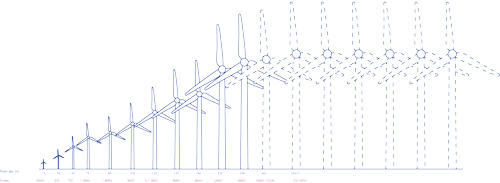 For a comprehensive course in wind energy that I teach, I spend a lot of time updating the numbers for the cost of various turbine components and their percentage of the total cost, as well as the cost of wind farms, for which turbine prices are only one part. As many may know, this is not a straightforward process, since the expenses are case sensitive, and there are no clear-cut figures for this.
For a comprehensive course in wind energy that I teach, I spend a lot of time updating the numbers for the cost of various turbine components and their percentage of the total cost, as well as the cost of wind farms, for which turbine prices are only one part. As many may know, this is not a straightforward process, since the expenses are case sensitive, and there are no clear-cut figures for this.By Ahmad Hemami, McGill University, Montreal, Canada
In a publication by the U.S. Department of Energy, some figures are given for offshore and onshore turbines, after extensive data gathering for several years. This, however, goes back to 2016, the data for which is probably based on the prices in 2012–2015.
For me, from an engineering viewpoint, the cost of wind energy is calculated based on the sum of all the costs. For, say, a 25-year project, this includes the initial cost, the interest on the invested money, the maintenance and running costs, the usual expenditure like insurance and so on, plus a reasonable profit.
Based on these points, the cost of wind turbines and wind energy has dropped from the initial days because of the progress in technology and increase in turbine size, which implies better efficiency as well as a smaller per unit (of energy) cost. In addition, although offshore wind farms are much more expensive to develop than onshore farms, the per unit energy cost is less due to steadier and stronger wind.
Having said that, as the turbine size increase will ultimately reach a limit, more likely around 20MW (Figure 1), we can expect that the cost of wind energy will approach a limit, in the same way as the turbine size.
It seems, nonetheless, that in figuring out the cost of wind energy, the issue is not the engineering and economics calculations. There was a noticeable price drop in wind energy (and photovoltaic, PV, solar energy) in 2021, as reported by the International Renewable Energy Agency (IRENA) and other sources. According to IRENA, ‘The global weighted average levelised cost of electricity (LCOE) of new onshore wind projects added in 2021 fell by 15%, year‑on‑year, to US$ 0.033/kWh, while that of new utility-scale solar PV fell by 13% year-on-year to US$ 0.048/kWh and that of offshore wind declined 13% to US$ 0.075/kWh’. This decline in cost has been despite rising material and equipment prices.
Listening to a recent webinar on wind energy, the keynote speaker was referring to this price fall. According to him, not only was the bidding price for certain projects relatively low, these projects did not expect subsidies from the local government; on the contrary, they involved some return in the form of tax, or similar. This is the way the cost declined, and a new price was set for both wind energy and PV solar energy. The bidding for later projects followed the new price.
From this reality, one suspects that the price set this way is somehow superficial and not a real representation of the cost. For sure, no company can sell below the cost. That is, either the producers had previously charged too much (which does not seem to be the case) or later they will end up with a loss if they are bidding low just for competition and a price war.
The good thing about wind and solar energy is that wind and sunshine are neither imported nor bought. In this way, unlike the case of oil and gas, there are no harmful effects as a result of price rises, political games or greed, as far as the raw fuel (wind, sunshine) is concerned. Then comes the cost of manufacturing, installation, and other regular expenditure, which is subject to all the market turmoil.
Although setting a price for still-developing production is a complex issue, I suppose the companies have a good deal of experience in realising the way to go – in terms of the technology to use for future wind turbines – to avoid falling into the pitfalls of the monopoly of a product, raw material, etc., due to political practices and other reasons.
Further Reading
https://www.irena.org/publications/2022/Jul/Renewable-Power-Generation-Costs-in-2021
https://weatherguardwind.com/how-much-does-wind-turbine-cost-worth-it/
https://blogs.scientificamerican.com/plugged-in/wind-energy-is-one-of-the-cheapest-sources-of-electricity-and-its-getting-cheaper/
https://www.nrel.gov/docs/fy21osti/78471.pdf
https://www.forbes.com/sites/energyinnovation/2020/01/21/renewable-energy-prices-hit-record-lows-how-can-utilities-benefit-from-unstoppable-solar-and-wind/?sh=47184abc2c84
https://www.irena.org/publications/2022/Jul/Renewable-Power-Generation-Costs-in-2021
https://weatherguardwind.com/how-much-does-wind-turbine-cost-worth-it/
https://blogs.scientificamerican.com/plugged-in/wind-energy-is-one-of-the-cheapest-sources-of-electricity-and-its-getting-cheaper/
https://www.nrel.gov/docs/fy21osti/78471.pdf
https://www.forbes.com/sites/energyinnovation/2020/01/21/renewable-energy-prices-hit-record-lows-how-can-utilities-benefit-from-unstoppable-solar-and-wind/?sh=47184abc2c84